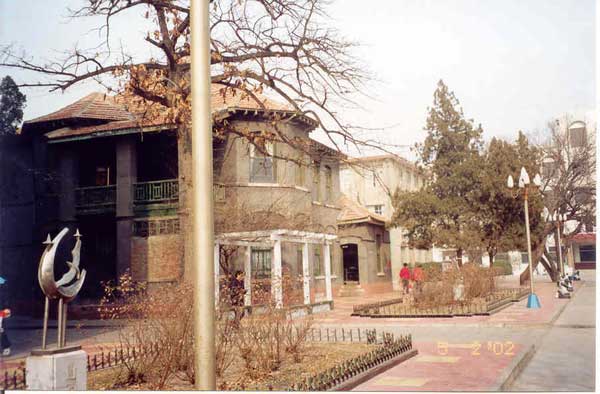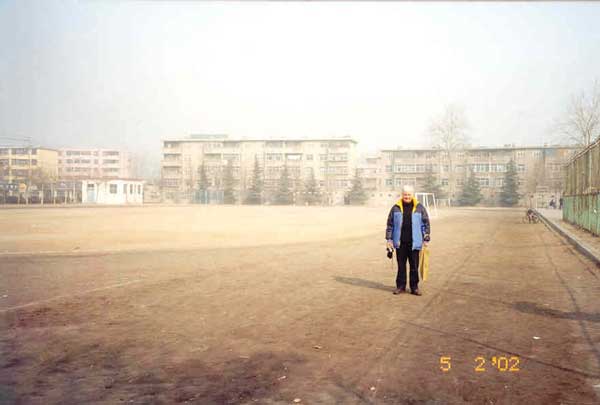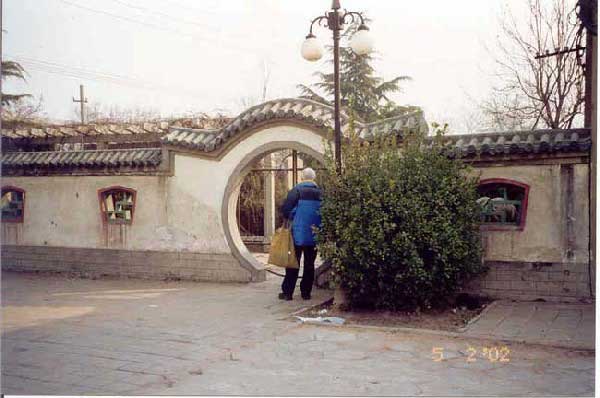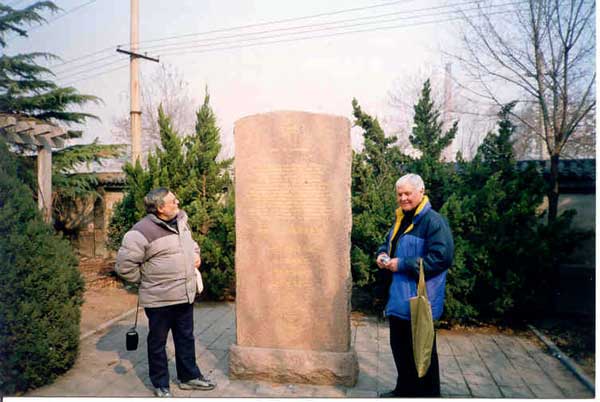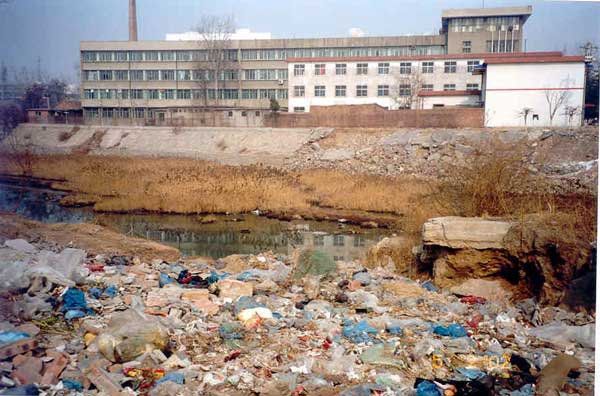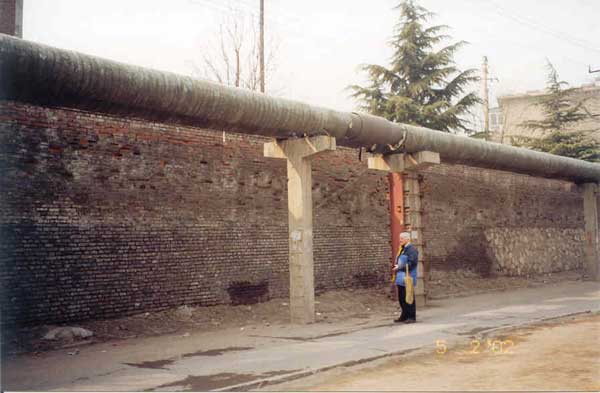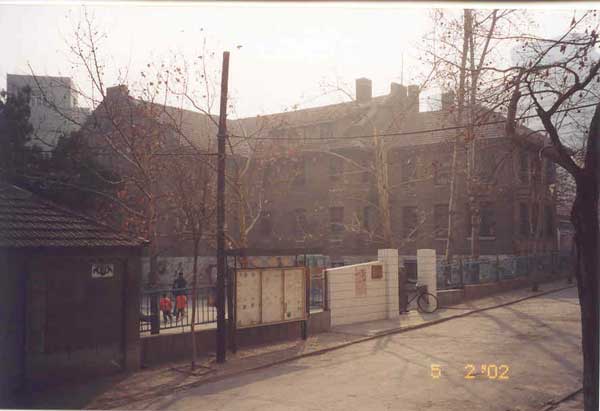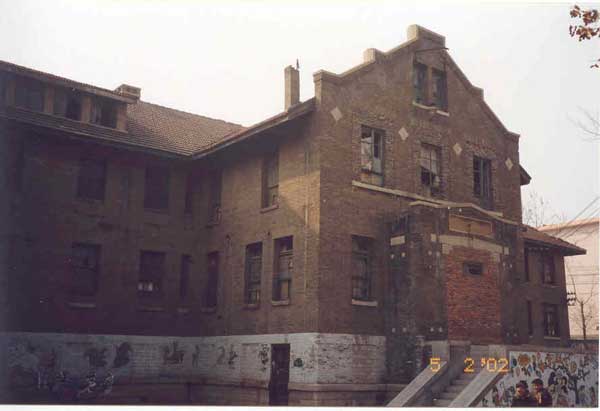from Ray Moore
DIARY ENTRY – 5 FEBRUARY 2002
Visit by Raymond and Frank Moore and Chinese friend, Jo, to Weifang, site of the former Weihsien Concentration Camp.
(Written by Raymond Moore with some additions to indicate where the 15 photos were taken.)
We got a taxi to the No.2 Middle School which, we were told (and I think it is mentioned in David Michell's book) is the site of the old Weihsien camp. We spoke to the gatekeeper - all schools seem to have a gatekeeper who can be fairly authoritative - and he was pleased to let us in and suggested we go in to the headmaster's office to get further permission.
As we stood at the gate (picture 1) ...
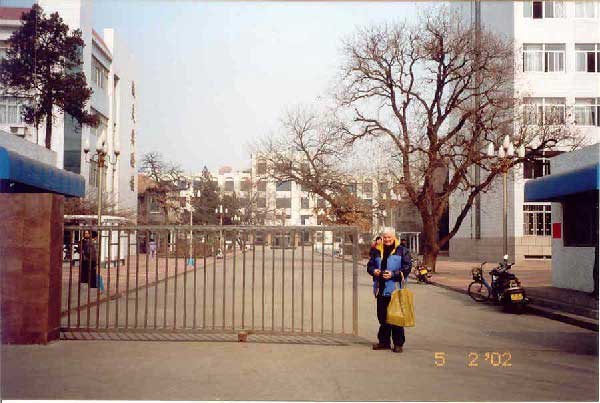
... immediately ahead of us was a large building which was obviously the main administrative building. We entered and walked up the drive and found, amongst the new buildings clad with the ubiquitous tiles, two old buildings, one on either side of the drive. (pictures 2 and 3)...
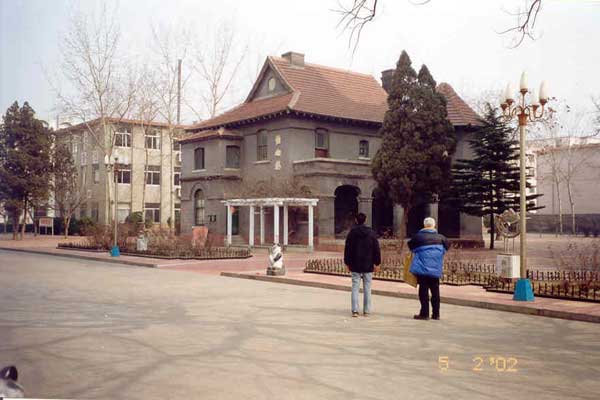
... By this time I had worked out that we were in the former area occupied by the Japanese. We found our way, with a little help, to the headmaster's room in the main administrative building. The man we met was actually the chief administrator, not the headmaster, as today is the first day of the Spring Festival Holiday - Chinese New Year - and the headmaster was not around. He was most helpful and knew what we were talking about and went out and brought in a copy for Frank and I of a handbook for the Eric Liddell Foundation. I was wrapped to get this.
He then went on to say that Block 23 which is the building in which I lived for practically the whole time there, was exactly in the position of the building we were now in. It had been knocked down in 1986 to make way for the present building. I was very sad about this as David's book mentioned that he returned in 1985 and the building was still there minus the bell tower. It would have been nice to see the rooms in which I lived during that time. But, as the man we were talking to said, we have to move on, so maybe there is some kind of closure in not being able to see it.
We were encouraged to walk around and see what we could see so we went out the other side of the building and there was a large playing field and basketball courts and not much else to see. Still I was able to visualise the place as it has been and we took a couple of pictures.(picture 4) ...
... The school has 4,000 pupils and has huge white tiled buildings to cater for such a large enrolment. We were approached by a very pleasant girl who had been a student and was now doing an English major in the Teachers College who introduced herself as Alice and spoke excellent English. She was visiting the college to catch up with one of her former teachers. Even though the school is big, it only takes up a part of the land on which the concentration camp stood. The man who was accompanying us told us that next door was a large hospital and that there was one of the old buildings still there.
But first we went to the back of the school and made for the place which used to be our front gate. The school faces exactly the opposite direction to the way the camp faced. It was not hard for me to find this and locate where the front gate would have been, and near to this was a rather attractive little garden (picture 5) ...
... which was under lock and key and in which was a large stone tablet in memory of Eric Liddell set up by the Eric Liddell Foundation. The key was located for us and we went in and took some photos. (pictures 6, 7 and 8) ...
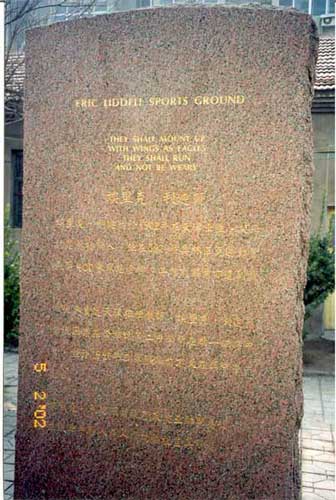
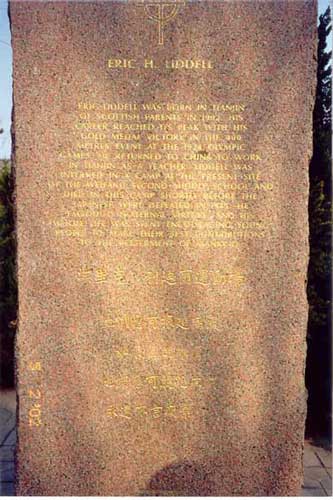
... There is something nice about him being remembered here in a place which has moved on and in some cases made deliberate attempts to erase the colonial and missionary past.
We were at a wall which looked down over a laneway which would have been the road in front of the camp in the old days and we could see a huge concreted in drain (you might call it a creek or a river) which was the creek that used to run just a few metres in front of the camp. We made our way around and found the lane and walked down it. It was a real country lane with people living out their lives there and, most obvious to us, was the fact that as in the majority of China, there is no system of rubbish disposal so it was all dumped in stinking heaps outside their houses and on the river bank. We stood there and took some pictures while I described to Frank that none of those houses were there in 1945 when the Americans dropped by parachute to liberate the camp. A few metres in front of the camp was this creek and then there were open fields with the usual burial mounds scattered about. (picture 10)...
... When the Americans landed by parachute they immediately drew their pistols and hid behind the burial mounds thinking that the Japs might resist their approach. The Japs didn't and in fact it was us internees who for the first time in a number of years, rushed out the gate and across the creek and went to welcome them. It was also in that area that most of the parachutes of food and other supplies were dropped over the next few weeks. It was a 10 year old's dream as loads of chewing gum broke apart and tins of peaches were scattered about, some having broken open too.
Although there was no obvious sign of it I took pictures of the place where the front gate used to be (picture 9) ...
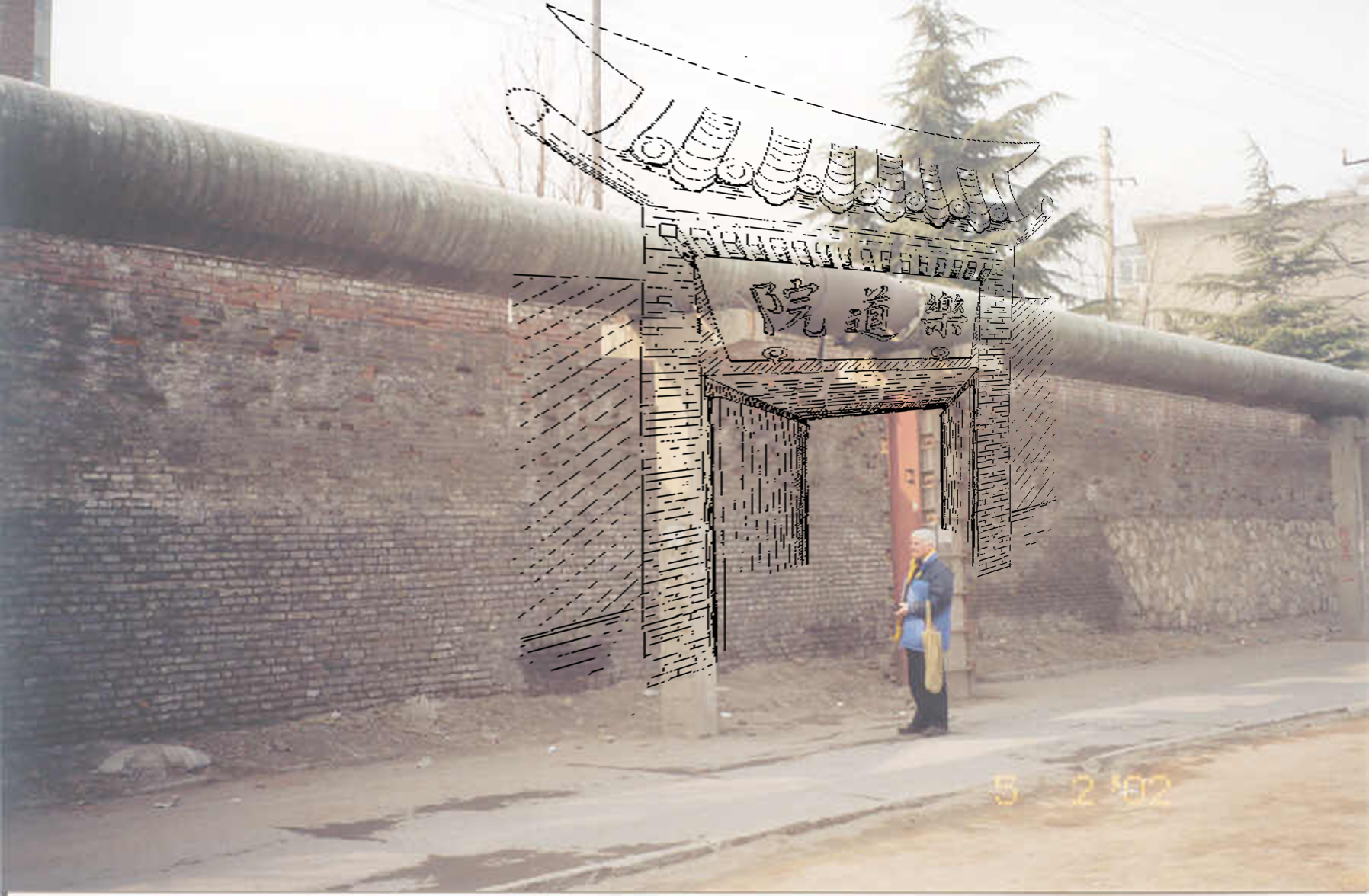
... and have no doubt of my accuracy in this. We then walked next door to the back entrance of the hospital property and immediately found the old hospital building (picture 11) ...
... which I remember so well where the Boys and the Girls schools were housed during our internment. I spotted the front steps and the kitchen for the hospital patients. (pictures 12 and 13) ...
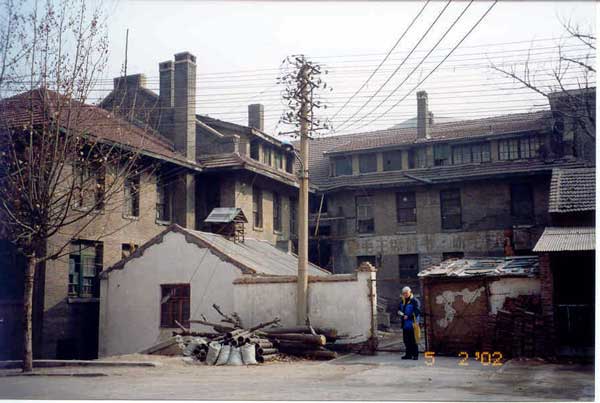
... We wandered around taking pictures (picture 14) ...
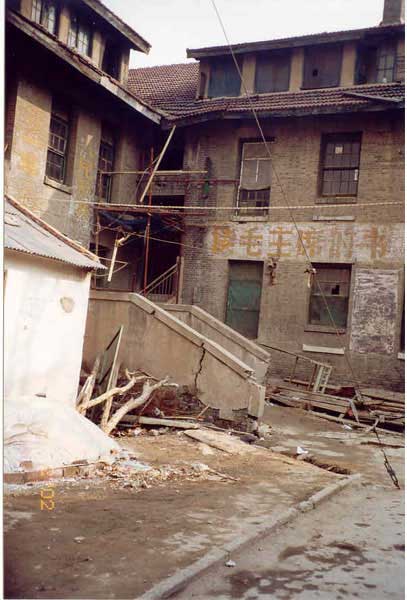
... and came across a corner stone on the building which had the date 1924 on it and above that had been the name of the hospital, but during the Cultural Revolution some industrious Red Guard had come along with a stone chisel and hammer and chipped away at the name to obliterate any sign of the decadent westerners who had been here. However it was not hard to work out that he had chipped away the letters which spelt "SHADYSIDE HOSPITAL" (picture 15) ...
... He had done the same with the Chinese characters giving the name of the hospital on the other side of the stone, but one of the women who was there with her children told us what the characters had been.
Also while we were talking there and Frank was entertaining a number of young children as it was a children's playground, a woman came along who told us that she had been in the building cleaning it and had found hidden in some high place some papers which included a picture of a foreign woman who was a nurse. Our informant lived too far away to go and get them to show us, but it set our imaginations on fire. Who had hidden this stuff? Was it one of the people who nursed in the camp hospital? Maybe it was one of the boys or girls school children and the picture was of their mother? Why was it hidden and why was it not collected when the person left the camp?
It was a good day.
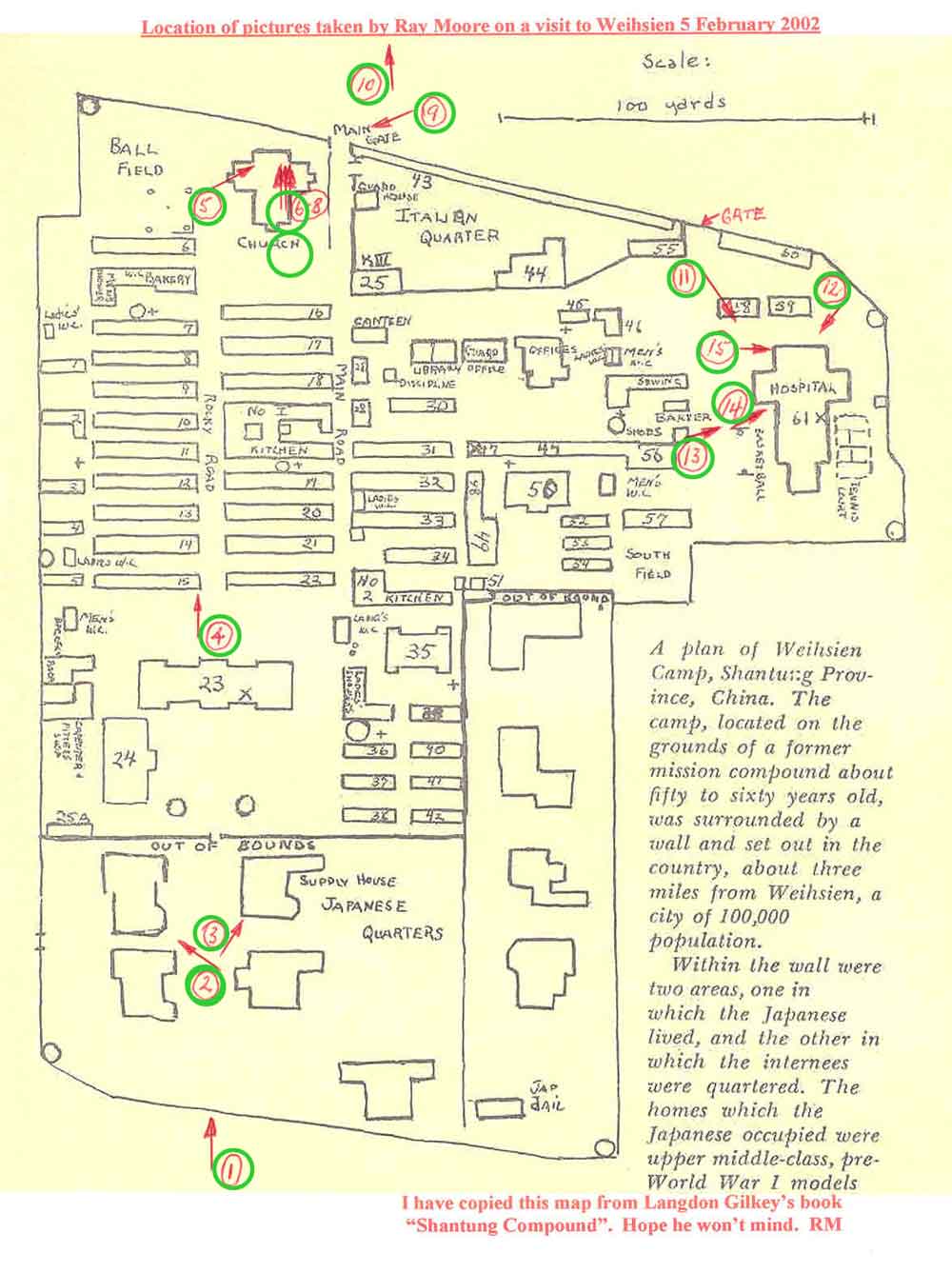
#
 |
|
